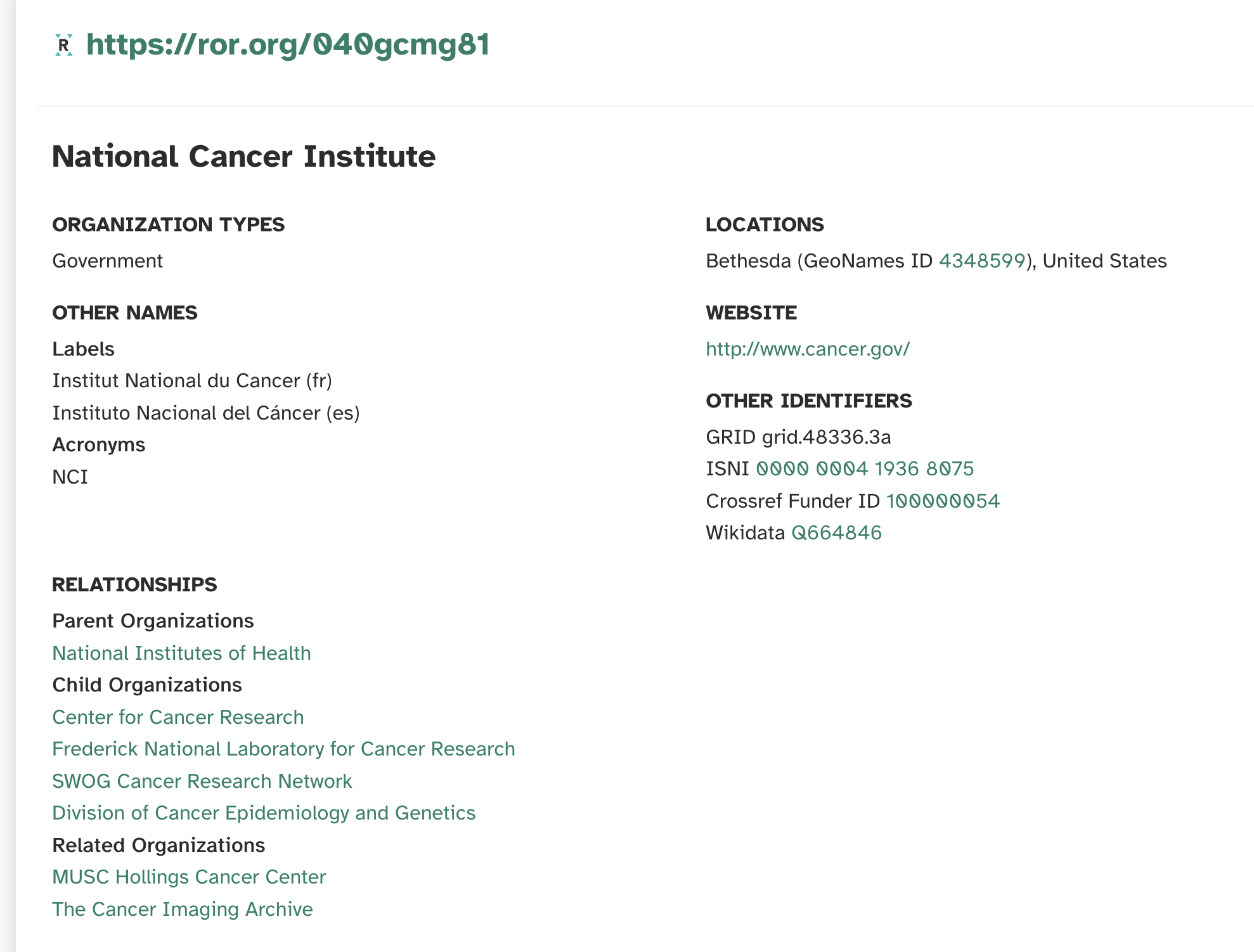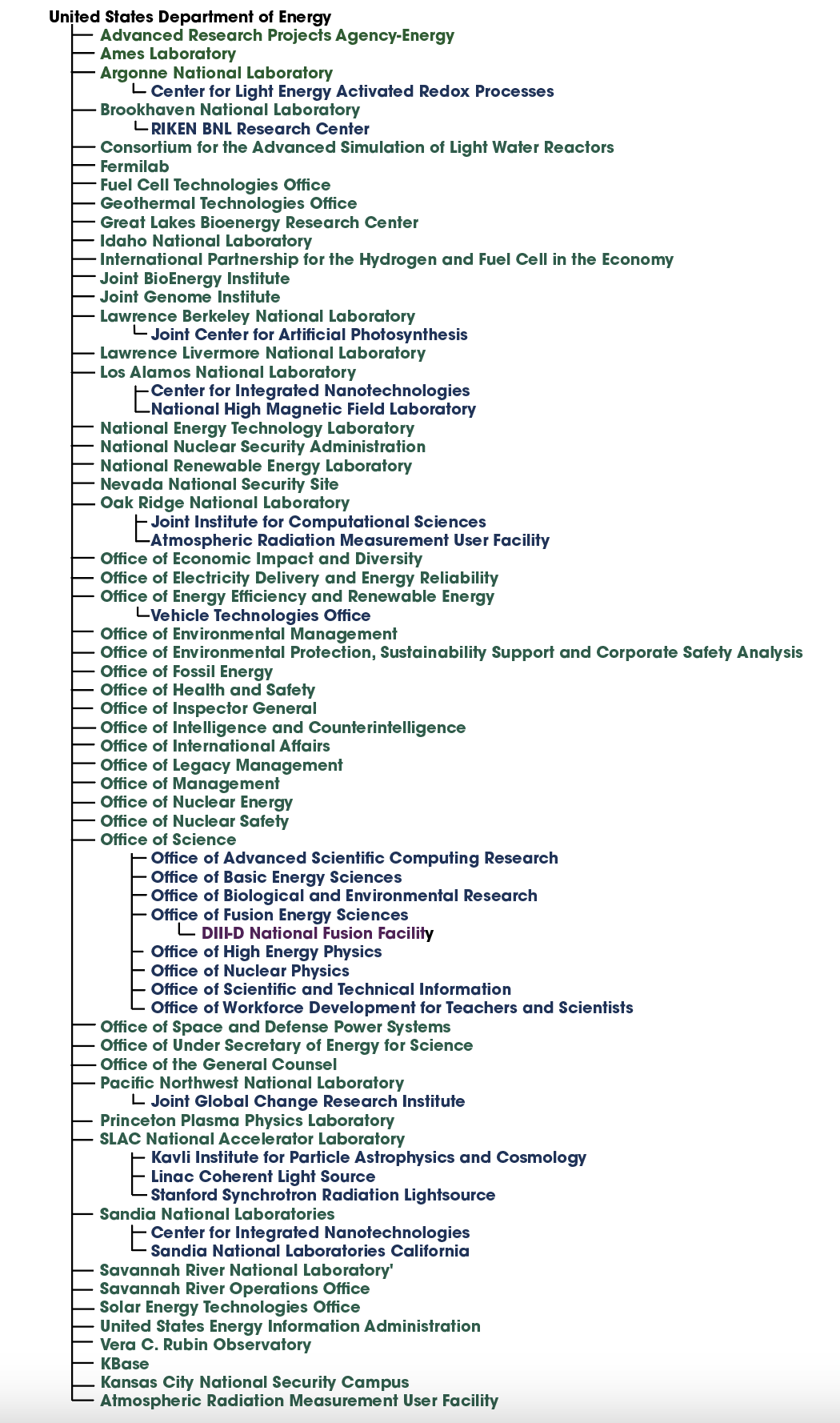Relationships and hierarchies
How ROR handles relationships
ROR records store both structural and temporal connections in the relationships field with the values "Parent", "Child", "Related", "Successor", and "Predecessor", allowing systems to understand and display organizational hierarchies and connections. The relationships element is an array, so organizations can have multiple children, multiple parents, and multiple lateral relationships.
If an organization ceases operations and passes on its work to another organization, that relationship is also reflected in ROR through the "Predecessor" and "Successor" relationship types. See ROR data structure: relationships for a full explanation.
JSON SchemaJSON schema documents used to generate and validate ROR records are available at https://github.com/ror-community/ror-schema.
Examples
The US National Cancer Institute is a child organization of the National Institutes of Health (NIH), and it also has multiple child organizations of its own and multiple related organizations.
{
"admin" : {
"created" : {
"date" : "2018-11-14",
"schema_version" : "1.0"
},
"last_modified" : {
"date" : "2024-01-10",
"schema_version" : "2.0"
}
},
"domains" : [],
"established" : 1937,
"external_ids" : [
{
"all" : [
"100000054",
"100008637",
"100007316"
],
"preferred" : "100000054",
"type" : "fundref"
},
{
"all" : [
"grid.48336.3a"
],
"preferred" : "grid.48336.3a",
"type" : "grid"
},
{
"all" : [
"0000 0004 1936 8075"
],
"preferred" : null,
"type" : "isni"
},
{
"all" : [
"Q664846"
],
"preferred" : null,
"type" : "wikidata"
}
],
"id" : "https://ror.org/040gcmg81",
"links" : [
{
"type" : "website",
"value" : "http://www.cancer.gov/"
},
{
"type" : "wikipedia",
"value" : "https://en.wikipedia.org/wiki/National_Cancer_Institute"
}
],
"locations" : [
{
"geonames_details" : {
"country_code" : "US",
"country_name" : "United States",
"lat" : 38.98067,
"lng" : -77.10026,
"name" : "Bethesda"
},
"geonames_id" : 4348599
}
],
"names" : [
{
"lang" : "fr",
"types" : [
"label"
],
"value" : "Institut National du Cancer"
},
{
"lang" : "es",
"types" : [
"label"
],
"value" : "Instituto Nacional del Cáncer"
},
{
"lang" : null,
"types" : [
"acronym"
],
"value" : "NCI"
},
{
"lang" : null,
"types" : [
"ror_display",
"label"
],
"value" : "National Cancer Institute"
}
],
"relationships" : [
{
"id" : "https://ror.org/05bjen692",
"label" : "Center for Cancer Research",
"type" : "child"
},
{
"id" : "https://ror.org/03v6m3209",
"label" : "Frederick National Laboratory for Cancer Research",
"type" : "child"
},
{
"id" : "https://ror.org/05n6zrm60",
"label" : "SWOG Cancer Research Network",
"type" : "child"
},
{
"id" : "https://ror.org/00vkwep27",
"label" : "Division of Cancer Epidemiology and Genetics",
"type" : "child"
},
{
"id" : "https://ror.org/01cwqze88",
"label" : "National Institutes of Health",
"type" : "parent"
},
{
"id" : "https://ror.org/00w52vt71",
"label" : "MUSC Hollings Cancer Center",
"type" : "related"
},
{
"id" : "https://ror.org/02qyzaf42",
"label" : "The Cancer Imaging Archive",
"type" : "related"
}
],
"status" : "active",
"types" : [
"government"
]
}In the ROR search interface, the number of relationships (if any) is shown on each record in the list view, and clicking the "View Details" button will take the user to the individual record, where all relationships are displayed.

Pictured below is an image of an organizational "family tree" created from ROR records with an organization tree script. The United States Department of Energy is the top node and has many "children" and "grandchildren" and one "great-grandchild" organization. (Laterally related organizations are not shown in this view.)

List of University of California system children and grandchildren expressed as nodes in an indented list from the ROR organization tree script written by Sandra Mierz.
Updated about 1 month ago
Read our blog post explaining in more detail how ROR handles organizational hierarchies and relationships
